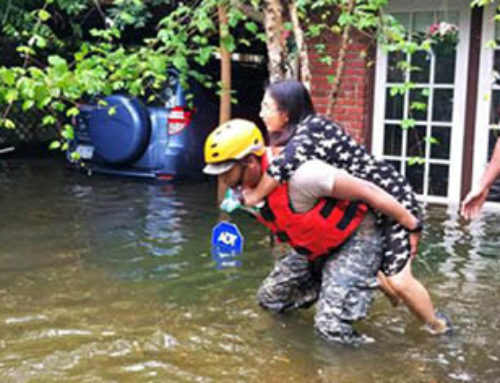Government funding isn’t the only thing facing a shutdown November 17th—the National Flood Insurance Program (NFIP) authorization will also expire, preventing the program from issuing new policies absent an extension. But even if thrown a lifeline, the NFIP will continue to face unparalleled risks and financial strain, which demand action to ensure both fiscal and environmental resilience.
The NFIP is at the forefront of the country’s vulnerability to climate change and the program’s finances—or lack thereof—contribute heavily to taxpayers’ fiscal burden. Furthermore, legacy subsidies in the program actually encourage development and redevelopment in areas with a high risk of flooding.
Founded in 1968, the NFIP is the primary source of flood insurance in the U.S., covering more than 4.7 million policies and $1.3 trillion in assets across 56 states and jurisdictions. It serves two main policy objectives: to provide primary insurance against flooding and transfer some financial risk from property owners to the federal government, and to mitigate the nation’s flood risk through establishing floodplain management standards. It also produces maps projecting flood risks and offers grants for flood-risk reduction.
NFIP is funded by policyholder premiums, annual federal appropriations, and for the last two decades, Treasury borrowing. Since 2005, the program has borrowed nearly $40 billion from the Treasury. NFIP also transfers some risk to the private sector through reinsurance and catastrophe bonds.
Over the last decade, the NFIP’s annual losses have varied significantly, reaching more than $10 billion in 2017 alone. At that point, instead of increasing the program’s $30.4 billion borrowing limit, lawmakers forgave $16 billion in debt. Still, as of 2023, the NFIP carries $20.5 billion in debt to the U.S. Treasury and pays approximately $300 million in interest expenses annually. These financial shortcomings beg the question: Is the NFIP structured to endure the mounting challenges of climate change?
The obvious answer is no.
Two recent studies deepen our understanding of the interplay between climate change and disaster impacts. The National Oceanic and Atmospheric Administration’s (NOAA) State of the Science Fact Sheet reveals escalating Atlantic hurricane activity since the 1980s, emphasizing increased risks of coastal flooding due to rising sea levels and likely upticks in hurricane intensities.
Complementing NOAA’s findings, a study in the journal Scientific Reports warns of climate change increasing the frequency of what were once considered 500-year flooding events, suggesting they may occur every 25 years by century’s end. This points to the urgency of rethinking how federal resources are allocated, particularly in flood-prone regions.
These climatic shifts necessitate a recalibration of the NFIP’s risk-assessment models to better align premiums with current environmental data. A more data-driven allocation of costs will ultimately support a more fiscally sound program.
In April 2023, FEMA fully implemented a new pricing methodology known as Risk Rating 2.0. Designed to correct rating disparities and reflect a broader range of flood risks, this change represents the most significant overhaul in the program’s history. Risk Rating 2.0 incorporates variables like flood frequency, multiple flood types, property elevation, and the cost to rebuild, allowing for more accurate and equitable premium calculations.
Disaster response capabilities also deserve renewed scrutiny. As flood risks escalate, it’s critical to invest proactively in robust first-responder teams and effective emergency resource supply chains. Such preemptive actions can counterbalance future disaster recovery expenses, reflecting a financially responsible strategy.
While Risk Rating 2.0 signifies progress, more work remains. It’s imperative that FEMA continues its engagement with Congress and stakeholders to ensure transparency about these changes and their implications for policyholders.
Congress is currently considering reauthorization of the NFIP, and the Administration is advocating for a range of reform principles to improve the program. Since its last long-term authorization ended on September 30, 2017, the program has been subject to at least 21 temporary extensions, including three brief interruptions in service. These constant short-term measures erode trust among current and prospective policyholders, further calling into question the NFIP’s dependability as a safeguard against flood risks.
The Administration is urging a 10-year reauthorization that includes comprehensive reforms to the program. These include making flood insurance more affordable for low- and moderate-income individuals through targeted assistance programs that offer discounted premiums while also educating them about the true risks of flooding. But they should go further to eliminate many of the existing property-based subsidies. The Government Accountability Office (GAO) has documented large cross-subsidies, many of which benefit high-income homeowners. The GAO found that over 78 percent of subsidized properties in NFIP are located in counties with the highest home values (the top three deciles), while only five percent of subsidized properties are in counties with the lowest home values (the bottom five deciles).
Additionally, FEMA administrators suggest enhancing the communication of flood risks and requiring minimum flood-risk disclosures during residential real estate transactions. Properties that have repeatedly experienced flood claims, which contribute to a disproportionate share of NFIP’s losses, are also being targeted for better management.
In other words, comprehensive and urgent reforms are needed to ensure the NFIP is both affordable for policy holders and fiscally responsible for taxpayers.










Get Social